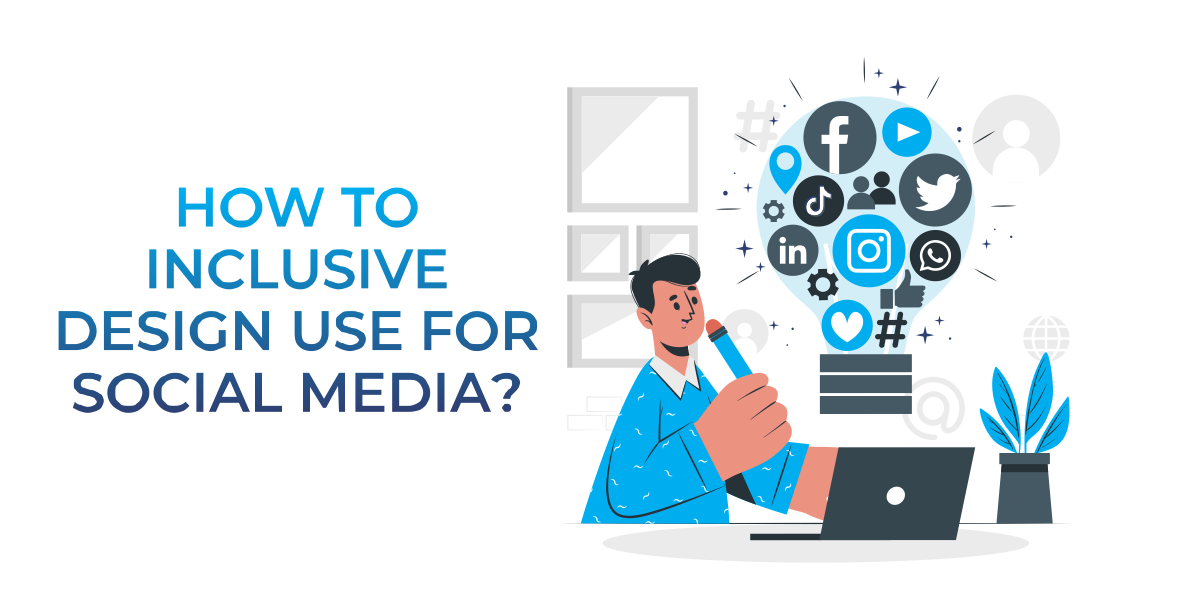The effectiveness of information distributed via social media is proportional to the number of people who see it, and inaccessible content excludes a large portion of readers and viewers. At the same time, visual content gives people a fun and expressive outlet. By removing barriers and providing a variety of ways for people to engage, inclusive design caters to a wide range of users.
Create an inclusive design to identify the most unique or extreme needs, also known as edge cases or stress cases. It aims to serve the broadest possible range of people and situations. More people will be able to enjoy content if an effort is made to make it accessible. Accessibility is improved by inclusive design. A Social Media Marketing Agency in Ahmedabad takes into account inclusive design accomplishes potential audiences.
Here are ways to Inclusive Design Use for Social Media:
1- Provide a caption for the image or alternative text.
Alternative text is an invisible description narrated through a screen reader, whereas image descriptions describe essential elements in a photo. Both make it easier for people with visual impairments to understand a photograph. Alt-image descriptions are available on Facebook, Twitter, Instagram, and LinkedIn. Facebook automatically assigns alt text to uploaded images, but it’s a good idea to double-check the generated text and make any necessary changes.
· CamelCase is used to create multi-word hashtags.
· Don’t use the same case for all of your hashtags. Instead, capitalize the first letter of each word to help screen readers distinguish between words in multi-word hashtags.
· CamelCase also improves the legibility of hashtags for everyone.
2- Make use of language that is inclusive.
Examine your text for bias and assumptions of limited points of view when writing copy. Avoid jargon and use plain, people-first language; more importantly, use gender-neutral terms, avoid ableist language, and minimize the impact of mental disabilities.
· Use descriptive call-to-action like sign up, read more, or subscribe than ‘click here’ whenever possible.
· Uniquely deliver the content.
· If color is crucial to understanding the image, mention it.
· Share your sense of humor.
· The text should be transcribed.
· GIFs aren’t to be overlooked.
3- For video content, use open or closed captioning.
You can manually add captions to your videos or use apps like MixCaptions and Clipomatic to do so. Captions for Facebook Live and IGTV have been generated automatically. Captions benefit people with hearing impairments and new language learners and viewers who are watching videos without sound. Even children were learning to read benefit from captions. It’s critical to make sure your video is suitable for silent viewing.
Captions can be generated automatically, written manually, or uploaded as a SubRip (.srt) file. Facebook Live and Workplace Live both have automatic closed captioning.
YouTube
Captions can be generated automatically, transcribed, or uploaded from a supported file. The caption editor can be used to correct errors. Automatic captions are available in English.
For IGTV Live and IGTV, automatic closed captioning is now available. Aside from that, video captions must be burned in or encoded ahead of time. Captions can be added to your Instagram Stories.
LinkedIn and Twitter
With your video, upload an. srt file.
4- Use at least a 4.5:1 color contrast.
Color contrast is essential for colorblind people and those who have switched to grayscale to avoid the dopamine rush that red notifications provide. Text color and its background should have a contrast of at least 4.5 to 1. This ratio decreases for larger text but increases for smaller text. The differences may appear minor, but they make a significant difference to different viewers.
· Combinations of green and red, or blue and yellow, are challenging to read.
· Text on images can be challenging to read; consider using a solid background or an opaque overlay.
· Consider using patterns to distinguish data on graphs and charts.
5- Learn about accessibility best practices and resources.
Accessibility fundamentals should be the starting point for inclusive design. The majority of SEO companies have accessibility guides that include best practices and tools. Keeping social media accessible strengthens your digital community. Being a great communicator entails doing just that.
6- Feedback is welcomed and embraced.
It’s unusual to get everything right the first time around. That’s why it’s critical to be receptive to feedback and to own up to your mistakes. Assist your community in having a safe and positive conversation. It provides contact information, a feedback form, or a prompt that directs your audience to a place where they can express themselves.
Conclusion
UX designers and web developers may appear to be the purveyors of inclusive design. However, social media marketers should put it into practice as well. Several social media platforms have recently improved their accessibility. Recognize exclusion, learn from your followers, and present information in the most precise way possible to keep social media accessible with the help of Digital Marketing services. And being a good marketer is all that matters. Fields for alt-image descriptions are now available on all platforms. Marketers should consider staying up to date on these changes. Social media marketing that is inclusive is good social media marketing.
Author Bio
Abhishek Trivedi
Abhishek Trivedi is a Marketer by Nature, and Digitally Skilled makes him a Digital Marketer. He is a Content Writer, Strategic Planner, Project Manager, Part artist, and Leader. He is the Founder of Digital Sky 360, which is a top Digital Marketing Agency in Ahmedabad.
